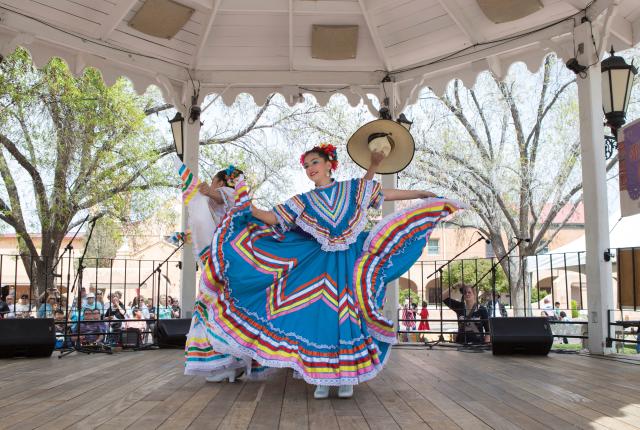Above: Florlórico dancers perform in the Old Town gazebo. Photography Courtesy City
of Albuquerque.
STILL STANDING
New Mexico’s largest city was long the home of Puebloan peoples and, in 1706, earned the Spanish government’s blessing as the new La Villa de Alburquerque, named in honor of Don Francisco Fernández de la Cueva Enríquez, the 10th Duke of Alburquerque, who was then the viceroy of New Spain (Mexico). Every year, the city celebrates Fiestas de Albuquerque (now spelled with just one r) in Old Town. From noon to 5 p.m. on April 7, the neighborhood bursts with kids’ activities, artists’ demonstrations, food vendors, dance-worthy bands, mariachi music, and a 3:30 p.m. Founders’ Procession in period costume. Your favorite stores and restaurants will be open, along with San Felipe de Neri church, one of the oldest buildings in town (505-768-2000, cultureabq.com). —Kate Nelson
ROADSIDE STOP
State Historic Marker: Brazos Cliffs
Location: Río Arriba County, in the Carson National Forest, on US 64 at mile marker 194
Jutting up 2,000 feet, the Brazos Cliffs contains some of the oldest rock in New Mexico—quartzite from the Precambrian era, 1.7 billion years ago. The cliffs mark a transition from the Río Chama Valley to the south, the Rocky Mountain highlands to the north, and the Tusas Mountains to the west. They help form the Brazos Box, a spectacular canyon through which the Río Brazos flows. —Excerpted from Roadside New Mexico: A Guide to Historic Markers, by David Pike (UNM Press).
Explore more roadside history at nmmag.us/RoadMarks.
TIME TRAVEL
Don Juan de Oñate inscribed his name into the cliff face at El Morro on April 16, 1605. Today it’s a national monument.
The first Atchison, Topeka & Santa Fe Railway locomotive steamed into Las Vegas, New Mexico, on April 4, 1879, turning it into a boomtown. On April 16, 1882, the Montezuma resort opened nearby. It’s now a United World College campus.
A botched hanging decapitated train robber Tom “Black Jack” Ketchum on April 26, 1901. His grave is in the Clayton Cemetery.
On April 1, 1941, a B-18 bomber became the first military aircraft to land at the Albuquerque Army Air Base, later Kirtland Air Force Base.
An April 4, 1956, federal order established the Fort Union National Monument, in Mora County.
Sid Cutter hosted the first Albuquerque Balloon Fiesta on April 8, 1972, with 13 hot-air balloons in the parking lot of Coronado Center shopping mall. —Kate Nelson


